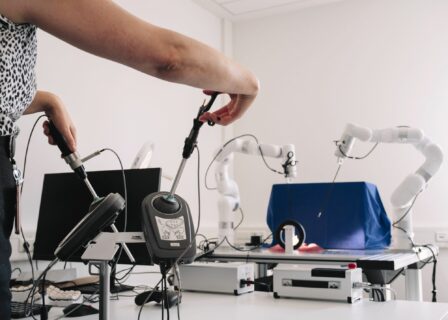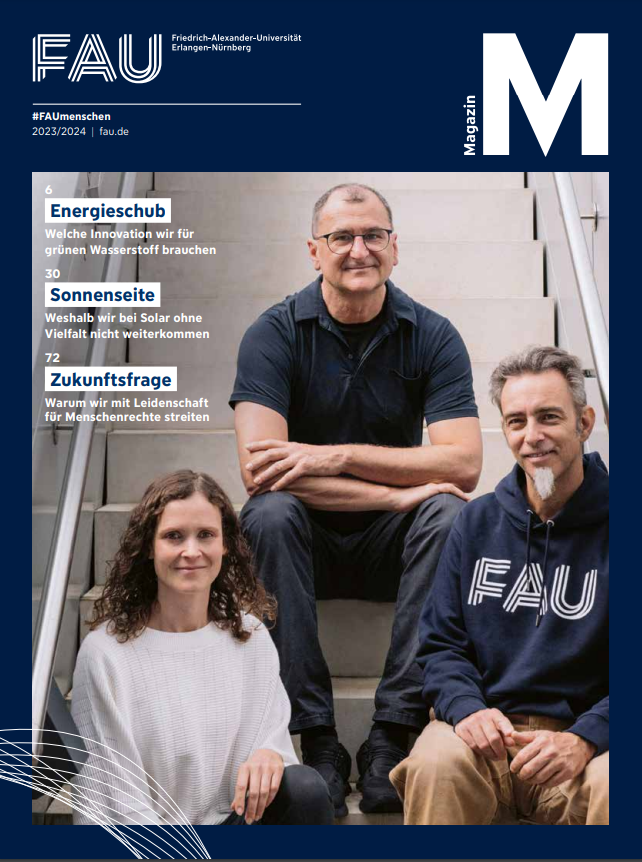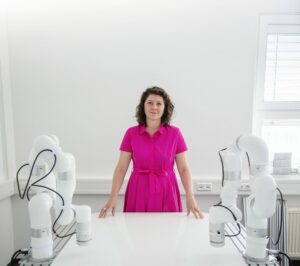Hand in Hand

About robots that assist during surgery
Artificial intelligence for medicine and robots that assist during surgery – that is Franziska Mathis-Ullrich’s area of research. Her professorship is funded by the High-Tech Agenda Bavaria.
Doctoral candidate Paul Scheikl holds an Xbox controller. It’s not a game he’s controlling, however, it’s a robot. A robot that is designed to be used for operating on humans in the future. “In this case, it is a robot for abdominal surgery, for example for operating on the liver,” explains Franziska Mathis-Ullrich. She is a professor at the Department of Artificial Intelligence in Biomedical Engineering (AIBE), where she is in charge of the Surgical Planning and Robotic Cognition Lab (SPARC).
In front of her is a table with two robotic arms mounted on its sides. The arms are holding a red cloth between them, marked with two colored dots, one green and one yellow. On his computer screen, Scheikl sees the cloth with the colored dots and two additional markings, again one green and one yellow. “The task is to bring the markings into the correct position. Yellow should go to yellow and green to green,” he explains. He uses the controller to guide the robotic arms, they pull the cloth into position. “It’s working pretty well already,” laughs Mathis-Ullrich. The plan is for the robot to be used later on in a hospital, where it will be expected to independently carry out the tasks of an assistant surgeon and support the team during an operation, entirely without anyone guiding it via a controller. “The human remains in control, however, like in a car with a driver assistance system,” explains Mathis-Ullrich. Working together with intelligent robots such as this is rare in general robotics, and has not been the case at all in medical robotics until now.
Driven by curiosity and passion
In SPARC, a whole team is conducting research into robotics and AI for the medical sector. Mathis-Ullrich sees this work as a bridge between technology and medicine. She particularly enjoys developing new ideas that connect hardware and software. “I am often asked if we can design a robot for all types of surgical interventions,” Mathis-Ullrich explains. However, she does not believe it would make sense to design a super robot that can operate on soft tissue at the same time as being suitable for use in orthopedics or neurosurgery. In her opinion, there is a reason why there are different disciplines in the field of surgery and why surgeons undergo training tailored to their specific specialty.
For this reason, research at her chair is split into various sub-projects, each of which focuses on a certain surgical area. Ramy Zeineldin and Nevin Matasyoh, for example, are conducting research into neurosurgery, with less of a focus so far on robotics and more on machine learning and AI. How does AI proceed, for example, when it performs segmentation of a tumor based on an MRI image? Zeineldin has developed a plug-in to understand the procedure in more detail. Matasyoh is developing a program that can be used to show trainee surgeons a video of an operation accompanied with the relevant explanation. “In future, the program should generate the explanatory texts itself with the help of AI,” explains Mathis-Ullrich. Her overall aim for the work in the SPARC Lab is to be able to model the hardware and software required for entire surgical processes, destined for use in clinical settings.
For this to be successful, she is particularly keen to encourage young scientific talents, especially women. “We can only reach our goals if we work together,” Mathis-Ullrich states. “The atmosphere in our SPARC Lab is very laid back, my team are driven by passion and curiosity. That is important, otherwise a research lab would not be the right place for you.”
by Laura-Grazia Indelicato
High-Tech Agenda Bavaria
Mathis-Ullrich’s professorship for medical robotics is one of 1,000 new professorships funded by the Bavarian state government as part of the High-Tech Agenda Bavaria (HTA). The aim of the HTA is to support areas of key significance for the future such as artificial intelligence, clean tech, and aeronautics, to strengthen Bavaria’s leading position in research and teaching, and to encourage the development of new ideas and the latest technologies and their practical application.
This article is part of the FAU Magazin

A university thrives because of the people who research, study, teach and work there. A university is supported by people who are connected to it as alumni, friends and sponsors and who are committed to promoting its interests all over the world.
They all contribute their unique talents, skills and perspectives. It is this diversity that makes our FAU a place of innovation, a place where many talented individuals tackle the major challenges of our times together, and a place where they keep finding answers.
Read more articles online Download: FAU Magazin (PDF)
